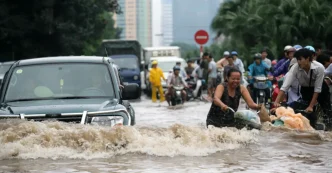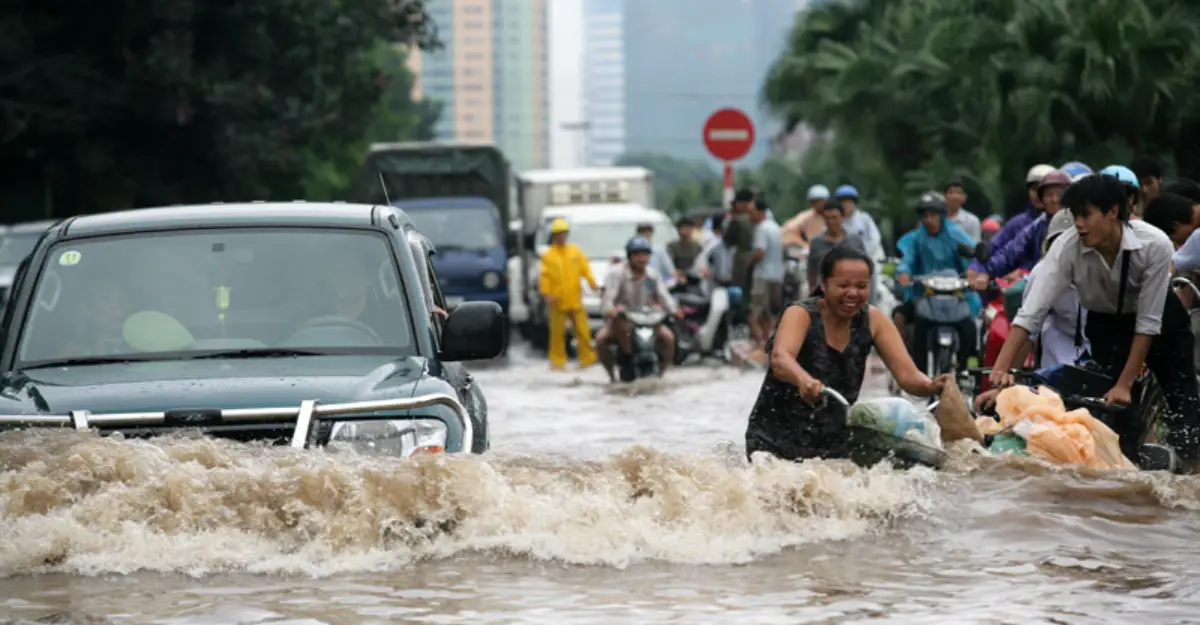HANOI – Torrential rains have unleashed widespread destruction across northern Vietnam’s mountainous provinces, triggering devastating floods and landslides that have claimed lives, damaged hundreds of homes, and left communities grappling with ongoing risks. As floodwaters slowly recede in some areas, large swathes of Thái Nguyên Province remain submerged, with authorities warning of continued heavy rain and heightened dangers of flash floods and further landslides.
Unrelenting Rains Batter Northern Provinces
Over the weekend of June 21, relentless downpours battered northern Vietnam, with rainfall measurements revealing the intensity of the deluge. Kim Sơn 2 in Hòa Bình Province recorded a staggering 274.8 millimeters of rain between 7 a.m. Saturday and 7 a.m. Sunday, while other areas like Dào San in Lai Châu and Phiêng Khoài 2 in Điện Biên each saw 110.6 millimeters. Bảo Hà 1 in Lào Cai and Yên Thế in Yên Bái also reported significant precipitation, with 93.6 millimeters and 106 millimeters respectively. These figures underscore the scale of the weather event that has overwhelmed local infrastructure and natural defenses.
The consequences have been dire. In Ba Bể District of Bắc Kạn Province, at least one person lost their life in a landslide, while another individual was injured in Thái Nguyên Province. More than 400 houses across Thái Nguyên, Bắc Kạn, Tuyên Quang, and Phú Thọ provinces have been inundated, with many families forced to flee their homes. Around 200 households in the hardest-hit areas are still awaiting evacuation, as emergency response teams struggle to reach isolated communities.
Thái Nguyên Bears the Brunt of Flooding
Thái Nguyên Province, located in Vietnam’s northern industrial heartland, has emerged as one of the most severely affected regions. Large parts of the province, particularly areas near the Cầu River in Thái Nguyên City, remain underwater. At midnight on Saturday, June 21, the river’s water level peaked at 2,743 centimeters, exceeding the Level 3 warning threshold of 2,700 centimeters by a significant margin. Although the water is now receding, the pace is slow, leaving residents and authorities on edge.
Nguyễn Văn Bắc, deputy chief of the Standing Office of the provincial Steering Committee for Natural Disaster Prevention and Search and Rescue, emphasized the coordinated efforts underway to mitigate the crisis. “Localities have been implementing disaster response and dyke protection plans” he said, highlighting the deployment of police, militia, and commune-level teams to manage the situation. These teams have established warning checkpoints at heavily flooded roads and diverted traffic to safeguard residents and vehicles.
Yet, for many in Thái Nguyên, the immediate danger persists. Homes and farmland remain submerged, and the emotional toll on families is palpable. The slow retreat of floodwaters has delayed recovery efforts, leaving communities in limbo as they await assistance and clearer skies.
Heightened Risks of Flash Floods and Landslides
Beyond the immediate flooding, the saturated ground across northern Vietnam poses a grave threat. Soil moisture models indicate that in several areas, the ground is either nearly saturated—over 85 percent—or fully saturated, dramatically increasing the likelihood of further landslides. Authorities have identified a high risk of flash floods in small rivers and streams, as well as additional landslides on steep slopes across 14 northern provinces.
This alarming forecast has prompted urgent calls for vigilance. Local governments in high-risk districts have been instructed to bolster preventive measures, including reinforcing dykes, clearing drainage systems, and preparing evacuation plans. The Vietnamese government, through its disaster response mechanisms, is mobilizing resources to support affected regions, but the scale of the challenge is immense given the forecast of continued heavy rain.
Climate Context and Systemic Challenges
The flooding in northern Vietnam is not an isolated incident but part of a broader pattern of increasingly frequent and severe weather events in the region. Climate scientists have long warned that Vietnam, with its extensive river systems and mountainous terrain, is particularly vulnerable to the impacts of climate change. Rising global temperatures are intensifying monsoon seasons, leading to heavier rainfall and more unpredictable weather patterns.
In rural and mountainous areas like Thái Nguyên and Bắc Kạn, the challenges are compounded by systemic issues. Limited infrastructure, including inadequate drainage systems and poorly maintained dykes, exacerbates the impact of heavy rains. Deforestation in upstream areas has also reduced the land’s natural ability to absorb water, accelerating runoff and increasing the risk of flooding and landslides downstream.
Moreover, many communities in these provinces rely on agriculture for their livelihoods, making them especially vulnerable to the destruction of crops and livestock. The financial burden of rebuilding homes and replacing lost assets is daunting for families already living on tight margins. While exact figures on economic losses are yet to be released, early estimates suggest that the damage to property and infrastructure could run into millions of Vietnamese Dong, equivalent to thousands in US dollars (exact conversions to be updated based on exchange rates at the time of publication).
Government Response and Community Resilience
The Vietnamese government has a well-established framework for disaster response, honed by years of dealing with typhoons, floods, and other natural calamities. Central and provincial authorities are working in tandem to provide relief, with emergency supplies, temporary shelters, and medical assistance being dispatched to affected areas. The deployment of local militia and police forces to manage traffic and ensure safety reflects a proactive approach to minimizing further loss of life.
At the community level, resilience is evident. In villages across Thái Nguyên and neighboring provinces, neighbors are helping one another salvage belongings, share resources, and provide shelter to those displaced. This spirit of solidarity, deeply rooted in Vietnamese culture, offers a glimmer of hope amid the devastation. Yet, as heavy rains are expected to persist, the strain on both communities and authorities is likely to intensify.
Looking Ahead: A Call for Long-Term Solutions
As northern Vietnam braces for more rain, the immediate focus remains on saving lives and stabilizing affected regions. However, the recurring nature of such disasters underscores the urgent need for long-term solutions. Investments in climate-resilient infrastructure, such as improved drainage systems and reinforced dykes, are critical to reducing future risks. Reforestation initiatives in mountainous areas could help mitigate runoff, while better urban planning in flood-prone regions might prevent the worst impacts of inundation.
Equally important is the need for enhanced early warning systems. While authorities have issued alerts and mobilized resources, the speed and accuracy of communication to remote communities can mean the difference between life and death. International cooperation, including partnerships with climate research organizations, could provide Vietnam with the tools and expertise needed to anticipate and respond to extreme weather events more effectively.
For now, the people of Thái Nguyên and other northern provinces face an uncertain path to recovery. The physical and emotional scars of this latest disaster will take time to heal, and the looming threat of further flooding casts a shadow over their efforts to rebuild. As the rains continue to fall, questions remain about how Vietnam can balance immediate relief with the broader imperative to adapt to a changing climate.
















